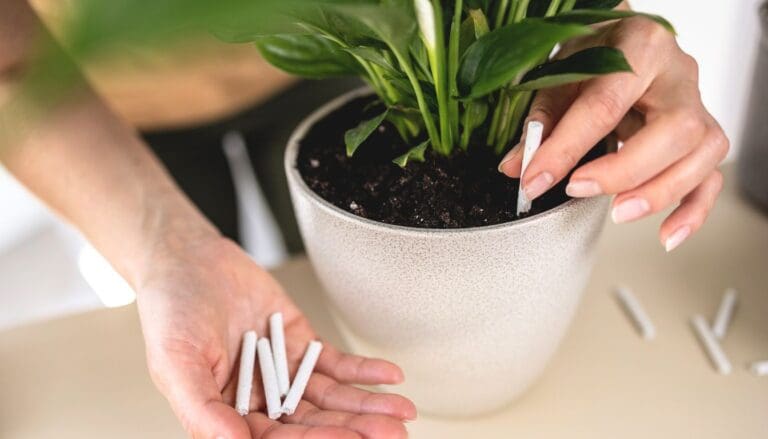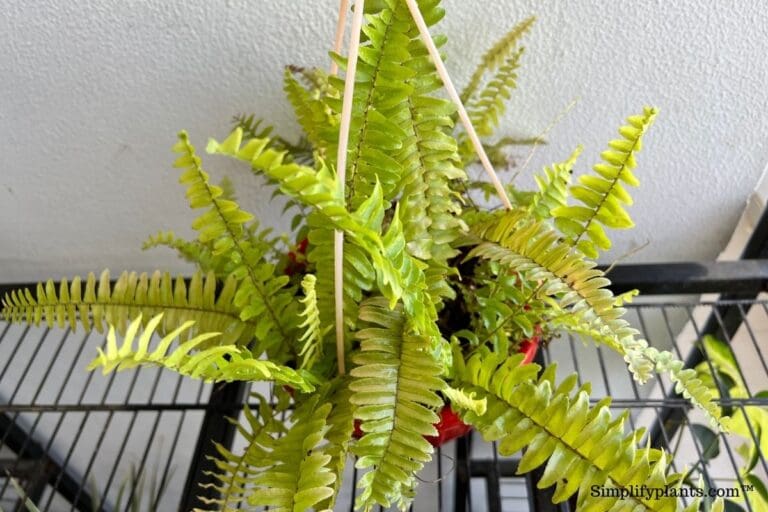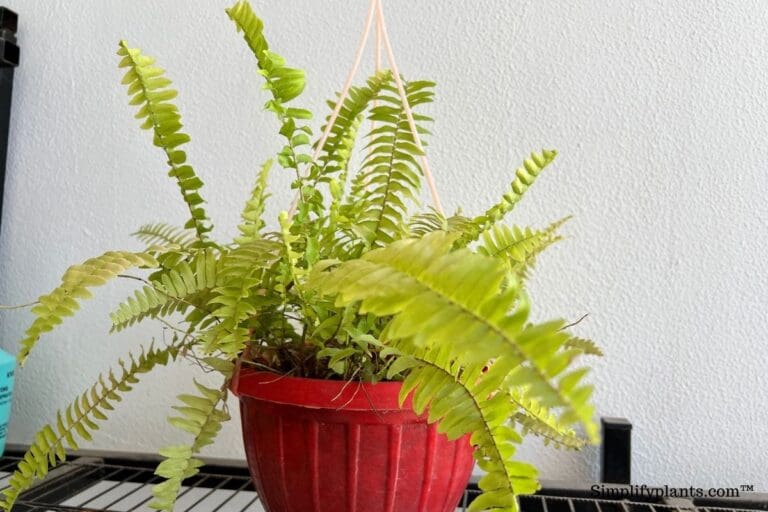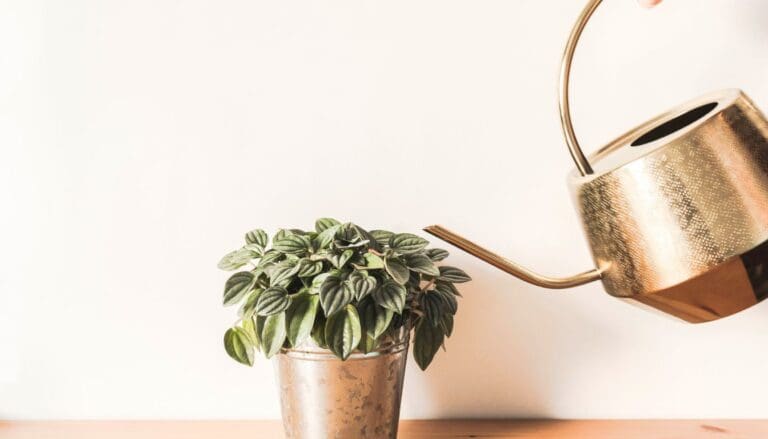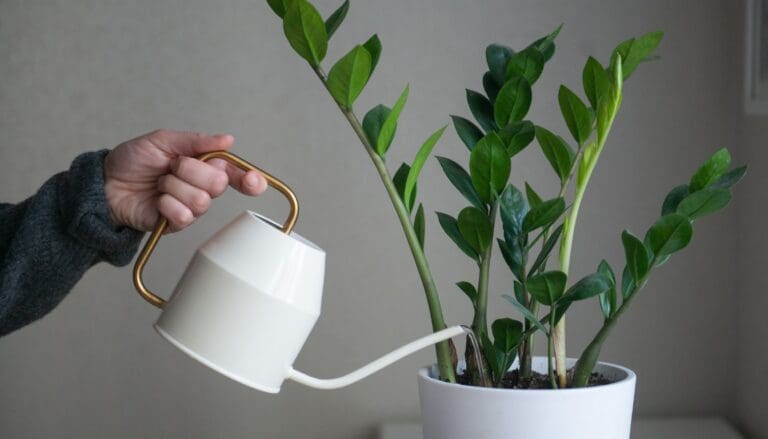Alocasia Leaves Turning Yellow? Why & Easy Fix!
Have you ever seen the leaves of your Alocasia plant turning yellow and wondered why it’s happening? This article will explore the reasons behind this and share some easy ways to fix it.
Incorrect watering is the primary cause of yellow leaves in alocasia. Lighting issues, improper fertilization, low-quality soil, pests, and diseases are other possible causes. Providing your alocasia with proper water, light, and temperature can help you fix this problem.
If you ignore your plant’s needs and do not give proper attention, you will notice yellow leaves on alocasia.
But don’t worry, as your plant can easily return to its normal health once you figure out the problem.
This article will discuss every possible reason behind yellow leaves in alocasia and their solutions.

Please note: Simplify Plants is reader-supported. Some links in the post are affiliate links and I get a commission from purchases made through links in the post.
Why is my alocasia turning yellow?
There can be various reasons that cause yellow leaves in alocasia.
You must understand each problem to find the exact cause and fix it accordingly.
All the reasons that can cause yellow leaves in your alocasia are:
- Overwatering
- Underwatering
- Incorrect lighting
- Temperature stress
- Low humidity
- Improper fertilization
- Low-quality soil
- Repotting stress
- Pests
1) Understanding How Overwatering Causes Yellowing of Alocasia Leaves
Alocasia likes to stay moist, but the soil should not be soggy.
Many people mistake watering the plant frequently because they believe it will make the plant grow faster, which is completely wrong.
When your alocasia is overwatered, the plant shows various signs of illness, including yellow leaves.
If you notice that your alocasia leaves have turned crispy, dry, and yellow, your plant is overwatered.
Alocasia should be watered when the topsoil is 25-50% dry.
Otherwise, they will get overwatered easily.
When the plant gets overwatered, the oxygen supply inside the soil gets blocked, and the root starts suffocating.
Because of this, the roots fail to function properly and fail to absorb nutrients and moisture, making the plant weak.
Due to weakness, the plant stops producing green leaves, and the leaves start to appear yellow.
Overwatering not only makes your plant weak but can kill your plant.
It can happen due to root rot. So, don’t neglect this problem at any cost.
Solution
- Don’t water your alocasia for some days until the soil becomes 25-50% dry.
- Keep your plant near a bright area so the soil dries up quickly.
- If your alocasia is undergoing root rot, repot your plant by eliminating all the infected roots and parts of the plant.
- Make sure you always check the moisture level before watering your alocasia. You can check either by inserting a finger or with a moisture meter.
Also read: How To Water Alocasia Plant? (How Much, How Often & More)
2) Impact of Insufficient Water on Alocasia Leaf Yellowing
Forgetting to water your plant is a common problem for most people.
If you do not water your alocasia on time and skip it frequently, your plant can suffer from dehydration.
Due to lack of water, the alocasia will not be able to get moisture and nutrients, which will make them completely dry and thirsty.
Thus, the plant will become unhealthy, resulting in crispy and yellow leaves in alocasia.
Being careless in the watering can make your alocasia develop various problems, so avoid doing this.
Solution
- Start watering your plant every day, gradually, so the water will get absorbed properly.
- Ensure you don’t water your alocasia all at once, as it can shock your plant.
- Don’t keep your alocasia in direct sunlight. Otherwise, the soil can get dry faster than normal.
3) How Improper Lighting Contributes to Alocasia Leaf Yellowing
The leaves can turn yellow if your alocasia is getting too much or low light.
Alocasia needs 6 to 8 hours of indirect light but not direct to thrive.
When your alocasia receives too much light, the leaves lose water due to increased transpiration.
This will dehydrate the leaves, resulting in yellow and dry leaves in alocasia.
Conversely, when your alocasia is not exposed to enough light, the chlorophyll will not work properly, and photosynthesis will slow down.
Because of this reason, leaf color will slowly start to fade away, which causes yellow leaves in alocasia.
Solution
- If your alocasia is getting too much light, try providing some shade or placing it in a shadier spot.
- If your plant was kept at low light, move the plant near a south-facing window, and make sure you use a sheer curtain to filter the direct sunlight.
- If natural light is not enough, then you can use artificial light. This also works as well as the natural sunlight.
Also read: What Kind Of Light Does Alocasia Need? Alocasia Light Requirements
4) Alocasia Leaf Yellowing and the Influence of Temperature Stress
Alocasia is a tropical plant and prefers warm temperatures between 65-85 degrees.
If the temperature drops below 55 degrees, it can cause stress to your alocasia, and it will start to show symptoms like yellow leaves.
Not only low temperatures but sudden temperature fluctuations can also trouble your alocasia.
It happens because your alocasia can’t adjust itself in the suddenly changing environment, which can be very stressful for your plant.
You should protect your alocasia from cold drafts, frost, and sudden temperature fluctuations if you don’t want your plant to get any health issues.
Solution
- Try to provide warm temperatures to your alocasia by using a thermostat device.
- Avoid keeping your alocasia near a window or door that gets cold drafts or frost.
- Don’t keep your alocasia near a window or door that is opened and closed frequently to avoid sudden temperature changes.
- Keep alocasia away from cooling objects, like near a refrigerator or in an Air conditioner room. This can stress your plant at an extreme level.
- Give indirect sunlight to your alocasia as much as possible to provide warmth.
5) Alocasia Leaf Yellowing Linked to Low Humidity Levels
Alocasias need high humidity to thrive and be healthy.
They prefer humidity that ranges between 50-60%.
Alocasia cannot tolerate low humidity conditions as the plant can become extremely dry.
When the humidity is low, alocasia loses all the moisture from the leaves because of transpiration.
This will make the plant extremely dehydrated as well as weak.
Due to dehydration and weakness, the leaves turn yellow, crispy, and dry, with brown edges.
Solution
- Mist your alocasia by spraying it with water. However, this is not a long-term solution.
- Keep other houseplants with alocasia to increase the humidity around that area through the transpiration of all the plants.
- You can also keep alocasia in the bathroom, kitchen, or basement as the humidity is quite high in those areas.
- If possible, use a humidifier device to maintain humidity inside the room.
- Don’t place your alocasia near a heating object, as the humidity is very low in those places.
Also read: Should I Mist My Alocasia? (Ideal Humidity+How To Maintain)
6) Alocasia Leaf Yellowing Due to Poor-Quality Soil Conditions
The entire health of your alocasia depends on the type of soil in which it is growing.
If the soil is poor, it directly affects the three sources: water, nutrition, and oxygen.
When the soil is wrong, it can create an unhealthy environment for alocasia, and it will refuse to grow properly.
The soil can have two problems: It is draining too fast or not draining properly.
If the soil drains too fast, the roots will not absorb enough water, and the plant can get easily dehydrated and weak, leading to yellow leaves in alocasia.
But if the soil drainage is extremely slow, alocasia can get waterlogged frequently, which can cause overwatering.
We have already discussed before how overwatering can lead to yellow leaves in alocasia.
Choosing the right soil mix is an important task; otherwise, it can create extreme trouble for your alocasia.
Solution
- You can change the entire soil with an even mix of regular houseplant soil, perlite, and peat moss.
- To improve the soil’s moisture retention, add compost, clay soil, or mulch the soil surface with organic matter.
- To improve soil drainage, you can add organic matter like compost, manure, sand, gypsum powder, and coco husk to the already existing soil.
Also read: What Kind Of Soil Does Alocasia Need? (Ideal Soil Mix+Other Requirements)
7) Understanding the Relationship Between Repotting Stress and Alocasia Leaf Yellowing
Alocasia needs repotting every 18-24 months or if the plant undergoes diseases like root rot.
Repotting is a task, and you should do it carefully.
Otherwise, it can cause extreme stress to your plant.
If you have repotted your alocasia incorrectly and not taken proper care of your plant after repotting, it can be very stressful for the plant.
Even a slight mistake can harm your alocasia, and it can start showing signs of illness like yellow leaves.
But, if your plant has recently been repotted or transplanted, it can face some difficulty adjusting itself.
This is not the thing to worry about as it is natural, and you might see yellow leaves because of a sudden changing environment.
Solution
- If your alocasia is already under stress due to repotting, give proper care.
- Make sure the pot you have chosen is 1-2 inches bigger than the previous one. If not, then change it.
- The pot should contain a good amount of drainage holes.
- Always keep the plant in the same place as it was before. Otherwise, a sudden change in the location can shock your plant.
- You should be careful while eliminating the injured roots and parts of alocasia. Always make sharp cuts and remove only the damaged parts.
- Always repot your alocasia during the summer and spring seasons but not in winter.
Also read: When Do You Repot Alocasia Plant? (Ideal Time+How To)
8) How Improper Fertilization Leads to Yellow Leaves in Alocasia
Fertilizing your alocasia is important for promoting healthy growth, but overdoing it can harm the plant.
Both under-fertilization and over-fertilization can cause yellow leaves on alocasia.
When your alocasia doesn’t get proper nutrients on time, it can make them weak, which causes yellow leaves.
Overfertilization can also weaken your alocasia as it burns the entire root and invites various pests and diseases.
This makes your plant unhealthy, which leads to yellow leaves.
But the main problem is understanding whether your alocasia is under-fertilized or over-fertilized.
Due to under-fertilization, the soil becomes extremely tight and cracked, and the plant stops growing.
During overfertilization, you will see a layer on the soil surface, stunted growth, wilting leaves, and a dehydrated plant.
Solution
- In case of underfertilization, fertilize the alocasia immediately with 20:20:20 liquid fertilizer.
- While fertilizing, never apply the raw fertilizer directly to the plant. You should always dilute the fertilizer with water and then apply it.
- In overfertilization, scrape off the top layer of the soil to remove the excess fertilizer.
- Wash the entire soil by watering the plant slowly. This will help to drain out the excess fertilizer from the soil.
- If the situation is out of your hands, repot your alocasia in a new pot with a fresh soil mix.
- Don’t fertilize your alocasia for a few months; wait until the plant is healthy again.
Also read: What Fertilizer To Use For Alocasia? (Ideal Fertilizer+Dosage Guide)
9) Identifying Pest Infestation as a Cause of Alocasia Leaf Yellowing
Pests like aphids, spider mites, mealybugs, scales, and larvae are the common insects that can attack alocasia.
Pests feed on leaves and suck out every necessary nutrient, thus, making the plant weak.
Because of such stress, the leaves start to turn yellow.
If you are taking care of your plant properly but still getting yellow leaves, you should take a close look at your alocasia to find out whether there are pests on it.
While checking for pests, check the undersides of the leaves as it is their common hiding spot.
Solution
- First, remove the infected parts of the plant.
- Then, wash your entire alocasia with a strong water spray to remove pests.
- To eliminate the remaining pests, use a wet cotton ball or a cloth by dipping into the isopropyl alcohol and then wiping the infected parts.
- Then use an organic pesticide on the entire plant. You can use Neem oil and water for spraying.
- You should spray this solution every 2-3 weeks to protect the plant from pests.
Also read: How Do I Get Rid Of Bugs In Alocasia? (+Common Bugs Identification)
How to prevent yellow leaves in alocasia?
Giving your Alocasia proper care can easily prevent the yellow leaves.
You should carefully keep all the points in mind if you don’t want any yellow leaves in alocasia.
- Give alocasia bright indirect sunlight as much as possible. If this is not enough, then use artificial lights. But keep it away from the direct sunlight.
- Water your alocasia only when the top layer of the soil dries, and avoid watering the plant during the winter months.
- Never let your alocasia stay in a bone-dry condition. The soil should be slightly moist all the time.
- Fertilize alocasia occasionally with a diluted fertilizer only during the growing months. Avoid fertilizing during the winter season.
- Spray a Neem oil solution once a month to keep the plant safe from pests and diseases.
- Repot your alocasia every 1.5-2 years so that the plant will not get root-bound.
- To avoid stressing your alocasia, don’t expose it to cold and hot drafts or near an area with temperature fluctuations.
- Use a soil mix that is well-draining and also has good moisture retention.
- Maintain humidity level inside the room by using a humidifier device.
- Always rotate your alocasia frequently to provide light in every part of the plant.
Should I cut off the yellow leaves?
It is impossible to recover the yellow leaves and bring them back to their green color. It happens in rare cases.
So, it is best to trim all the yellow leaves to promote better and healthy growth.
Not cutting the yellow leaves can block the growth of new green leaves and make your plant unhealthy. So cutting the yellow leaves off is the best option.

Reference: Alocasia sanderiana, Alocasia micholitziana.
Recommended Garden Supplies
| Product Image | Our Recommended Gardening Supplies | Check Offers! |
|---|---|---|
Top Top
Top
Top
Top
Top
Top
Top
Top | rePotme Houseplant and Tropical Classic Potting Soil Mix | Check Offer On Amazon |
 Top
Top
Top
Top
Top
Top
Top
Top | Espoma Organic Indoor Plant Food | Check Offer On Amazon |
 Top
Top
Top
Top
Top
Top
Top
Top | GooingTop LED Grow Light 6000K Full Spectrum Clip Plant Growing Lamp | Check Offer On Amazon |
 Top
Top
Top
Top
Top
Top
Top
Top | Soil Moisture Meter | Check Offer On Amazon |
 Top
Top
Top
Top
Top
Top
Top
Top | Govee Hygrometer Thermometer, Bluetooth Enabled! | Check Offer On Amazon |
 Top
Top | LEVOIT Humidifiers for Large Room(Best For Plants) | Check Offer On Amazon |
 Top
Top
Top
Top
Top
Top
Top
Top | Upgraded DIY Automatic Drip Irrigation Kit, 15 Potted Houseplants Support | Check Offer On Amazon |
 Top
Top
Top
Top
Top
Top
Top
Top | Stainless Steel Heavy Duty Gardening Tool Set | Check Offer On Amazon |
 Top
Top
Top
Top
Top
Top
Top
Top | Bonide Insecticidal Soap | Check Offer On Amazon |
 Top
Top
Top
Top
Top
Top
Top
Top | Bonide 32 oz Spray Neem Oil for Organic Gardening | Check Offer On Amazon |
 Top
Top
Top
Top
Top
Top
Top
Top | Garden Safe Fungicide | Check Offer On Amazon |


